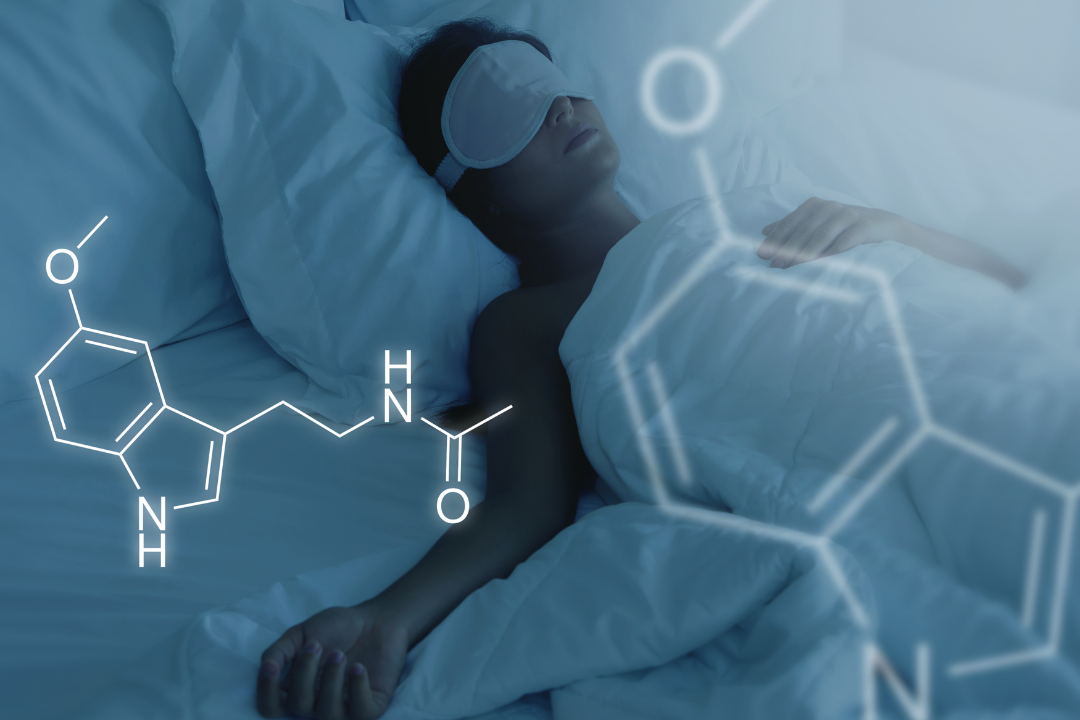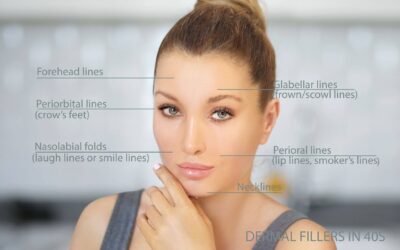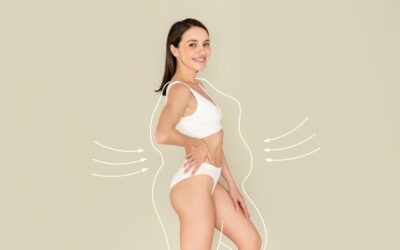Author: Meredith Horton, MD is a 4th year resident at Brown Emergency Medicine Residency
Faculty Reviewer: Kristina McAteer, MD
Throughout medical school and residency training, I’ve lost count of the amount of times I’ve heard the phrase “I’ll sleep when I’m dead.” Working as much as possible, while spending as little time sleeping as possible, has historically been glorified.
This approach is misguided. Research has shown that getting a sufficient amount of sleep (7-9 hours per night) is necessary for longevity and to function at the level that is demanded in the field of medicine [1].
Throughout this blog post, we will take a deep dive into sleep, its stages, and functions. We will talk about what governs when we sleep, what happens when we don’t sleep, and finally discuss how to optimize sleep, especially as shift workers.
What is sleep?
Sleep is a reversible state of unresponsiveness during which we stop perceiving the outside world. But unlike states of sedation such as those induced by general anesthesia or alcohol intoxication, sleep is a physiologically complex process. During sleep, our brain is extremely active and is undergoing multiple processes to restore our brain and bodily functions.
It consists of two phases:
- Non-Rapid Eye Movement (NREM) Sleep
- Rapid Eye Movement (REM) Sleep
Our brain cycles through these stages in 90-minute intervals (Figure 1) [1].
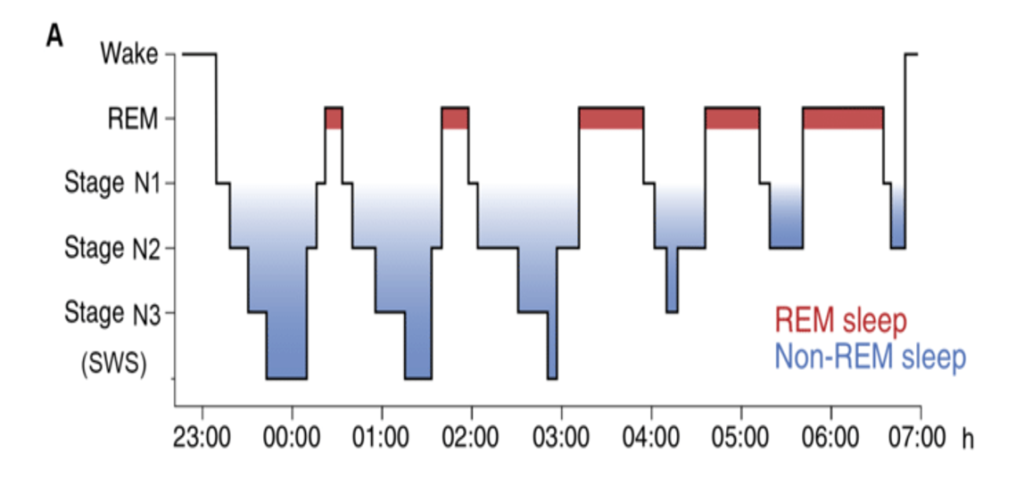
As shown in Figure 1, the architecture of these 90 minute intervals changes throughout the night. Earlier in the night, we spend a greater proportion of time in NREM sleep and throughout the night, these 90 minute blocks are made up of progressively more REM sleep.
If we are only able to sleep a few hours, we do not get equal amounts of REM and NREM sleep. As we discuss the functions of each stage of sleep, it will become clear how missing a proportion of either stage can be detrimental.
NREM
Divided into four stages; stages 1-2 are known as light NREM and stages 3-4 are deep NREM or slow-wave sleep.
Functions:
-Restores musculature and cardiovascular system, partially via bolus of growth hormone that stimulates protein synthesis, endothelial damage repair and muscle restoration and growth.
-Plays important role in learning and memory formation. Converts short term memories in hippocampus into long term memories in the cortex.
-The glymphatic system, which cleans the brain and disposes of toxic/metabolic byproducts and waste, is most active during this stage of sleep
REM (Dream sleep)
Referred to as “paradoxical sleep” because our active brain waves resemble those of someone awake, while our voluntary muscles, except for the extraocular muscles, are complete paralyzed.
Functions:
- REM is the predominant stage of sleep in utero and helps with brain maturation and synaptogenesis
- Fine tunes and recalibrates the emotional circuits in our brain by helping us to learn to read facial expressions and social cues.
- Helps us process stressful or traumatic experiences – referred to as “overnight therapy”
- Plays a different role in learning and memory by helping integrate knowledge, relate distant concepts, inspire creativity
What governs when we sleep?
- Homeostatic sleep drive – our innate desire to sleep is driven by buildup of adenosine. Adenosine accumulates gradually throughout the day creating a pressure to sleep
- Circadian rhythm – our internal clock, controlled by suprachiasmatic nucleus in the hypothalamus. Receives light input via photosensitive cells in the retina
- External factors including light, temperature, food intake, exercise and caffeine affect our homeostatic sleep drive and circadian rhythm.
*a note on temperature – temperature is the effector of circadian rhythm, the medium by which our body communicates to the rest of our body where we are in our sleep/wake cycle
Figure 2. Balance between homeostatic sleep drive (buildup of adenosine) and circadian rhythm governs our sleep-wake cycle [1]
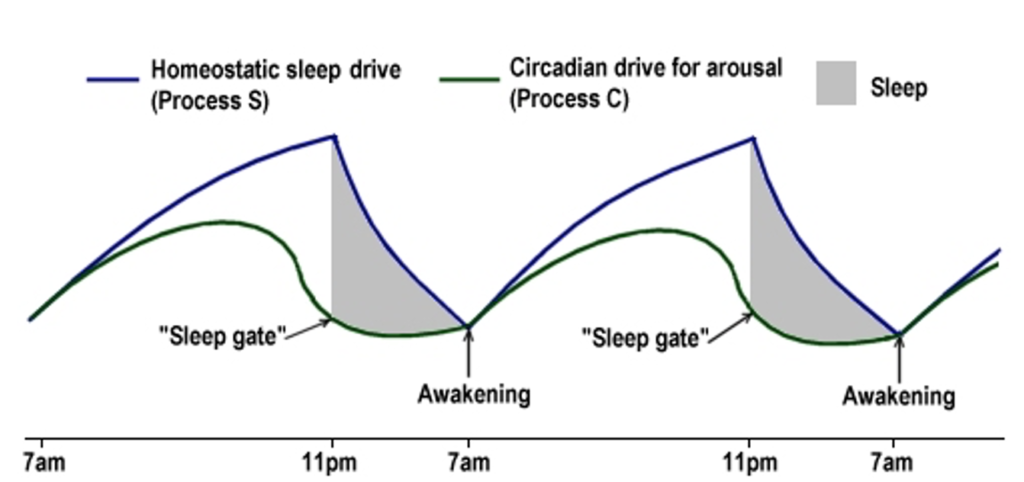
The detrimental effects of sleep deprivation:
On the mind…
- Impaired concentration
- Emotional irrationality
- Impaired learning and memory
- Bidirectional relationship to mood disorders – increases symptoms in those with mood disorders or susceptible to mood disorders
- Increases risk of developing Alzheimer’s disease
On the body…
- Increased risk of developing or dying from coronary disease, even after controlling for known risk factors [2]
- Increased risk of developing insulin resistance and type II Diabetes Mellitus [3-5]
- Increases susceptibility to gain weight by decreasing leptin levels, increasing ghrelin levels and craving high calorie/high sugar foods [8]
- Weakens the immune system [6,7]
- Increases risk of certain types of cancer, including breast, prostate, endometrial and colon
- WHO classified night shift work as probably carcinogenic
- Lower testosterone levels [9]
- Increases rates of abnormal menstrual cycles
- 80% more likely to be sub-fertile and suffer first trimester miscarriage
How to master your sleep
- View light (ideally sunlight) soon after waking to set your circadian rhythm for the day
- Minimize light exposure within a few hours of planned bedtime (including overhead lights, LED, phones/iPads, TV)
Figure 3. Body temperature changes throughout the day to communicate the circadian rhythm to our body. The act of body temperature rising tells us that it is time to wake up. The act of body temperature falling tells us that it is time to sleep.
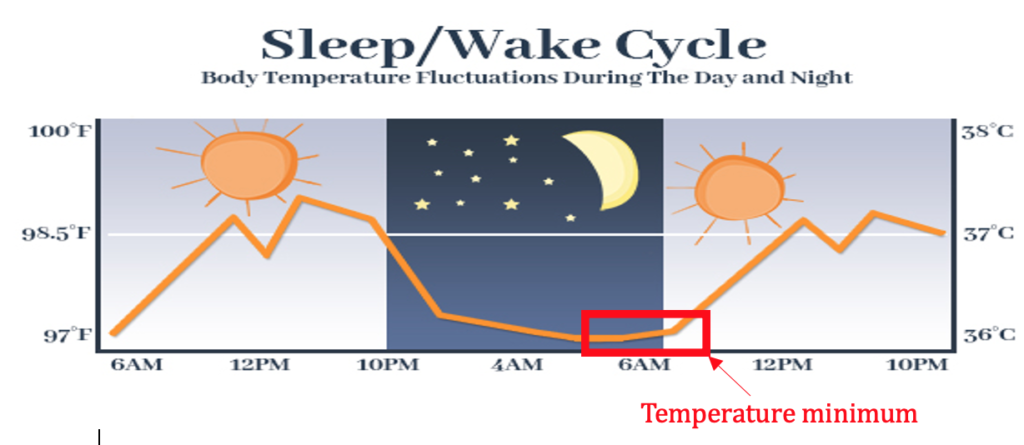
- Body temperature can be manipulated to facilitate waking up or falling asleep.
- Cold water immersion/shower causes rebound thermogenesis that raises body temperature and facilitates wakefulness
- Hot showers cause a rebound cooling effect that lowers body temperature and facilitates sleepiness
- Sleeping with an ambient temperature of ~65 degrees F has been shown to help our body reach the temperature it needs to fall asleep
- Know your temperature minimum. This occurs 90-120 minutes before waking. If you view light within 4 hours after temperature minimum, this will phase advance your clock, thus allowing you to fall asleep earlier and wake up earlier. If you view light 4-6 hours before your temperature minimum, you will phase delay your clock, making you want to go to bed later and wake up later.
- Exercise raises the body temperature, thus facilitating wakefulness. Exercising within the first few hours after waking can help phase advance your clock.
- Be wary of exercising close to bedtime as the delay in peak body temperature can delay falling asleep
- Eating triggers an increase in metabolism and body temperature, thus facilitating wakefulness, except when large volumes of food are consumed and divert blood flow away from the brain
- Caffeine is an adenosine antagonist that temporarily counteracts our homeostatic sleep drive. Ingesting caffeine too late in the date (even up to 8 hours before bed) can affect depth of deep NREM sleep
- If you have trouble falling asleep or staying asleep, use the following tools to help calm the sympathetic nervous system:
- meditation
- yoga nidra
- non sleep deep rest (NSDR) protocols
- Napping can be beneficial as long as you are able to sleep at night
- If you anticipate needing to be awake for a prolonged period of time (night shifts), prophylactic napping has been shown to help minimize fatigue and microsleep
- Keep naps less than 90 minutes
The Ugly Truth
- Alcohol is a REM sleep inhibitor and causes more frequent brief awakenings. It causes unconsciousness, not sleep
- THC also likely inhibits REM sleep
Melatonin
- Signals that it is time to sleep; does NOT facilitate actually falling asleep
- Has questionable benefit in otherwise healthy adults
- Should probably be avoided in children/teenagers as melatonin also plays important role in timing secretions of puberty hormones
- May be helpful in elderly people, who have a flatter melatonin curve
Summary
- Sleep is a physiologically complex process that restores a multitude of brain and body functions
- Everybody needs 7-9 hours of sleep per night. No exceptions.
- Your lifespan is directly correlated with the amount of sleep you get
- Sleep is governed by homeostatic sleep pressure and the circadian rhythm
- Early morning light viewing and minimizing light exposure before bed are crucial in setting circadian clock and triggering regulatory hormone release
- Exercise, meal timing, and deliberate hot or cold exposure can help adjust our circadian rhythm
- Avoid alcohol and THC before bedtime
- Melatonin and prescription sleep aids have questionable benefit in otherwise healthy adults [10]
References
- Walker, Matthew. 2018. Why We Sleep. Harlow, England: Penguin Books.
- Francesco P. Cappuccio, Daniel Cooper, Lanfranco D’Elia, Pasquale Strazzullo, Michelle A. Miller, Sleep duration predicts cardiovascular outcomes: a systematic review and meta-analysis of prospective studies, European Heart Journal, Volume 32, Issue 12, June 2011, Pages 1484–1492.
- Mesarwi O, Polak J, Jun J, Polotsky VY. Sleep disorders and the development of insulin resistance and obesity. Endocrinol Metab Clin North Am. 2013 Sep;42(3):617-34. doi: 10.1016/j.ecl.2013.05.001. PMID: 24011890; PMCID: PMC3767932.
- Buxton OM, Pavlova M, Reid EW, Wang W, Simonson DC, Adler GK. Sleep restriction for 1 week reduces insulin sensitivity in healthy men. Diabetes. 2010 Sep;59(9):2126-33. doi: 10.2337/db09-0699. Epub 2010 Jun 28. PMID: 20585000; PMCID: PMC2927933.
- Broussard JL, Ehrmann DA, Van Cauter E, Tasali E, Brady MJ. Impaired insulin signaling in human adipocytes after experimental sleep restriction: a randomized, crossover study. Ann Intern Med. 2012 Oct 16;157(8):549-57. doi: 10.7326/0003-4819-157-8-201210160-00005. PMID: 23070488; PMCID: PMC4435718.
- Prather AA, Janicki-Deverts D, Hall MH, Cohen S. Behaviorally Assessed Sleep and Susceptibility to the Common Cold. Sleep. 2015 Sep 1;38(9):1353-9. doi: 10.5665/sleep.4968. PMID: 26118561; PMCID: PMC4531403.
- Irwin M, McClintick J, Costlow C, Fortner M, White J, Gillin JC. Partial night sleep deprivation reduces natural killer and cellular immune responses in humans. FASEB J. 1996 Apr;10(5):643-53. doi: 10.1096/fasebj.10.5.8621064. PMID: 8621064
- Spiegel K, Tasali E, Penev P, Van Cauter E. Brief communication: Sleep curtailment in healthy young men is associated with decreased leptin levels, elevated ghrelin levels, and increased hunger and appetite. Ann Intern Med. 2004 Dec 7;141(11):846-50. doi: 10.7326/0003-4819-141-11-200412070-00008. PMID: 15583226.
- Leproult R, Van Cauter E. Effect of 1 week of sleep restriction on testosterone levels in young healthy men. JAMA. 2011 Jun 1;305(21):2173-4. doi: 10.1001/jama.2011.710. PMID: 21632481; PMCID: PMC4445839.
- Huedo-Medina TB, Kirsch I, Middlemass J, Klonizakis M, Siriwardena AN. Effectiveness of non-benzodiazepine hypnotics in treatment of adult insomnia: meta-analysis of data submitted to the Food and Drug Administration. BMJ. 2012 Dec 17;345:e8343. doi: 10.1136/bmj.e8343. PMID: 23248080; PMCID: PMC3544552.

